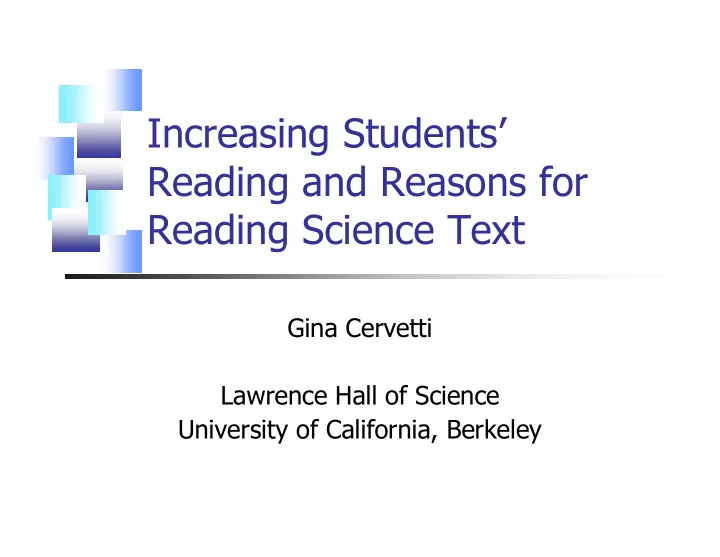

Increasing Students’ Reading and Reasons for Reading Science Text Gina Cervetti Lawrence Hall of Science University of California, Berkeley
Why Read in Inquiry Science? Linking activities and content in ways that enable students to make connections between experience and text: Motivates engaged reading (Guthrie et al., 2006) � Helps students develop deep understanding of science � concepts (Palincsar & Magnusson, 2001) Helps students use the discouse of science (Pappas et � al., 2004) Improves reading comprehension (Guthrie et al., 2006; � Romand & Vitale, 2001) Provides authentic opportunities for experience with � nonfiction and informational text
Connecting Text and Experience (Redux) � Employ multiple modalities (Do-Read- Write-Talk in any order) � Position science understanding as the goal and reading as one means � Create mutually reinforcing (even synergistic) experiences with text and hands-on activities � Use text in a variety of roles in the inquiry process
An Example A design challenge to develop strong glue. Conceptual goals: � Properties of substances � Mixtures � Dissolving
Read Read to Set Context Students read a book about the relationship between objects/mixtures, materials, and properties
Do Investigate to Test Ingredients Students test ingredients and mixtures to collect firsthand evidence about which ingredients are stickiest.
Talk Reflect on Results Students evaluate the test results and decide which ingredients to use to make their first glue mixture.
Read Read for Modeling Students read a book that models the design process and reflect on how they can use a similar property-driven design process to refine their glue mixtures.
Do & Write Investigate Additional Ingredients Students conduct more ingredient tests, this time focusing on the property of strength. Students collect firsthand evidence about which ingredients are strongest.
Read Read for Additional Evidence Students search in a handbook for evidence about ingredients that might have the properties need to make good glue.
Talk & Write Evaluate Evidence and Make Decisions Students evaluate their evidence about glue ingredients from both first and secondhand sources and make decisions about what combination of ingredients will best meet their design goals. They write recipes for glue.
Read Read to Connect Students read about a food scientist who designs and tests new jelly beans. Students reflect on how their design process is like that used by the jelly bean scientist.
Connecting Text and Experience (Redux) � Employ multiple modalities (Do-Read- Write-Talk in any order) � Position science understanding as the goal and reading as one means � Create mutually reinforcing (even synergistic) experiences with text and hands-on activities � Use text in a variety of roles in the inquiry process
What functions did text serve in the design process? Roles for Text in Inquiry Science Provide context Connect to the world outside the classroom Deliver content Read to learn about science Model Demonstrate a process or disposition Support secondhand Provide data for students to interpret investigations Support firsthand Provide information for investigations investigations
Provide Context � Connect to the � Introduce domain world outside the and/or context classroom � Invite students to engage with the context
Model � Model nature of � Model literacy science processes � Model inquiry processes
Support secondhand investigations � Provide data for students to interpret
Role: Support firsthand investigations � Provide information that facilitates firsthand investigations � Support students in making sense of firsthand investigations � Inspire firsthand investigations
Deliver Content � Deliver science information � Provide information and explanation about unobservable phenomena
Trade Books Context � Where Butterflies Grow by Joanne Ryder � Content � Zipping, Zapping, Zooming Bats by Anne Earle � Camouflage by Carolyn Otto � Modeling � Wild Mouse by Irene Brady � Protecting Primates by Kate Boehm Nyquist � Secondhand � What Do You Do With A Tail Like? This by Steve Jenkins and Robin � Page Introducing Frogs and Toads by Graham Meadows and Claire Vial � Firsthand � Tracks, Scats, & Signs by Leslie Dendy � Snails and Slugs from the Keeping Minibeasts series �
Authenticity in Science Scientists read to situate Provide Context research Scientists read to learn Deliver Content findings Scientists replicate others’ Modeling procedures and experiments Supporting Second- Scientists read and interpret hand Investigations others’ data and findings Supporting Firsthand Scientists use reference books Investigations
Text and Inquiry Provide Deliver Model Support Support secondhand context content firsthand inquiry inquiry 1 Explore the topic X X X X 2 Ask a question X X 3 Make a hypothesis X X 4 Plan and conduct an X X investigation 5 Record and organize X X data 6 Analyze results X X 7 Make an explanation X X X X based on evidence 8 Ask a new question X X 9 Communicate results X
Recommend
More recommend